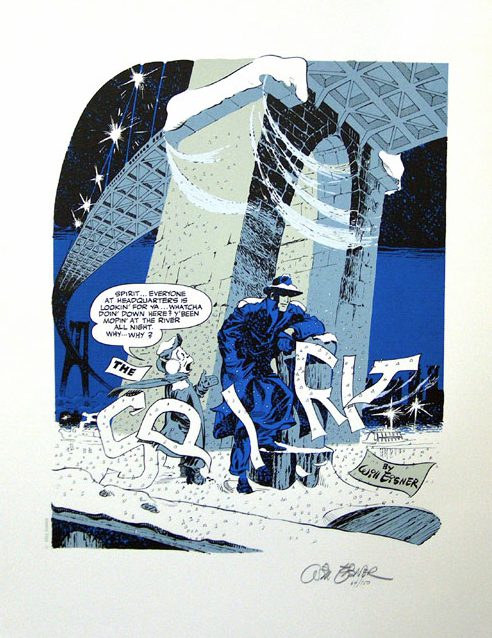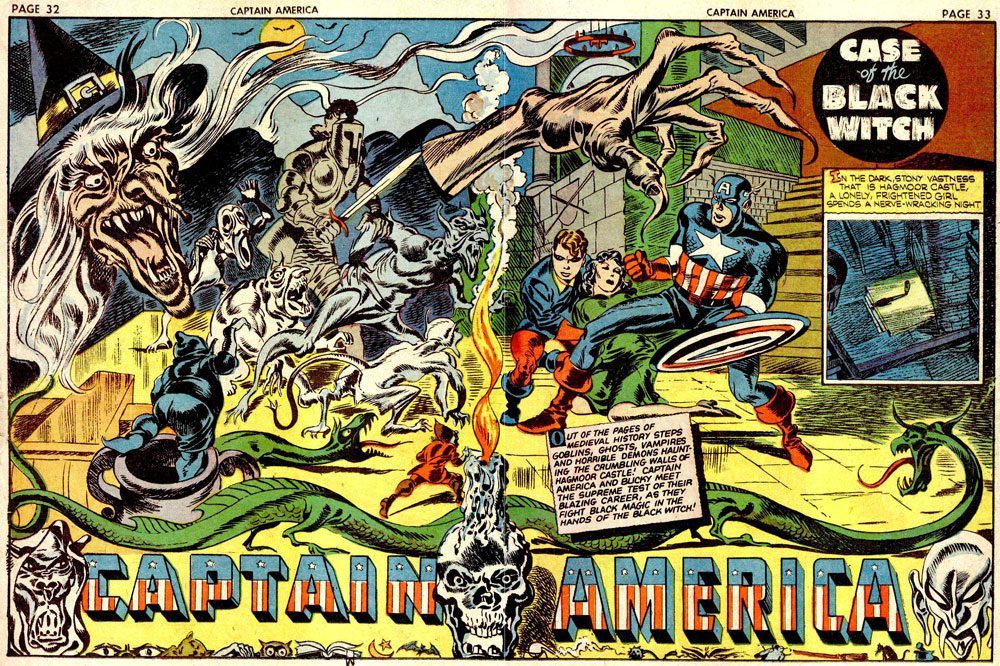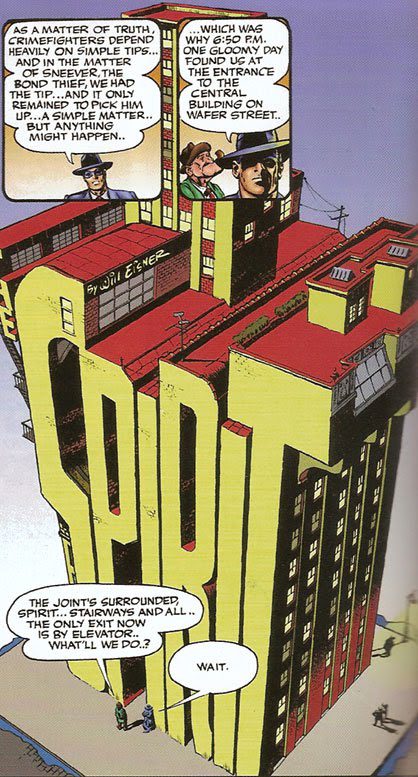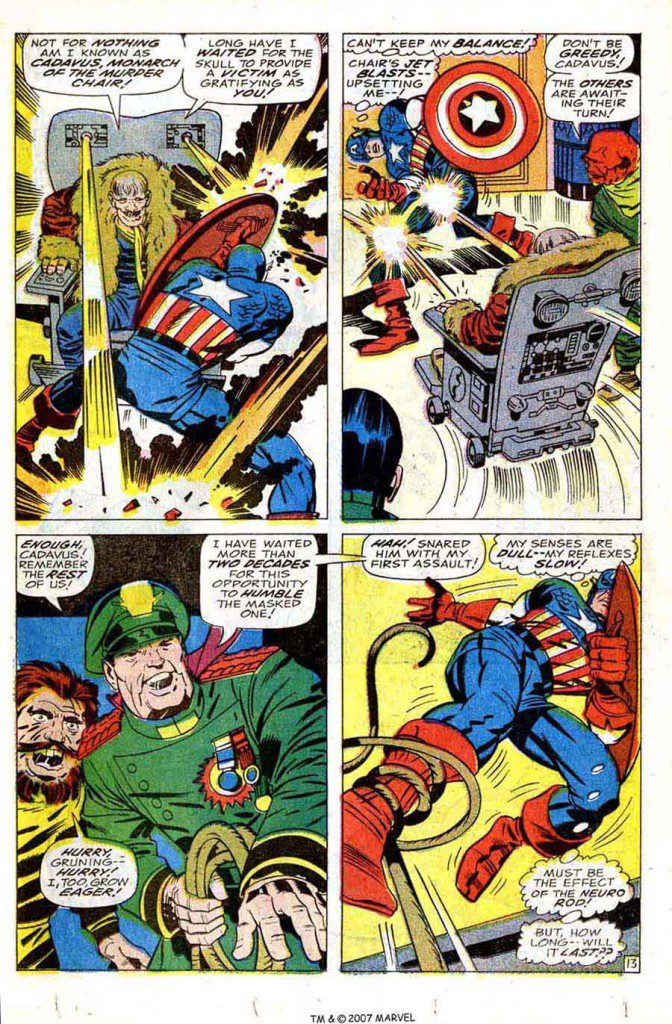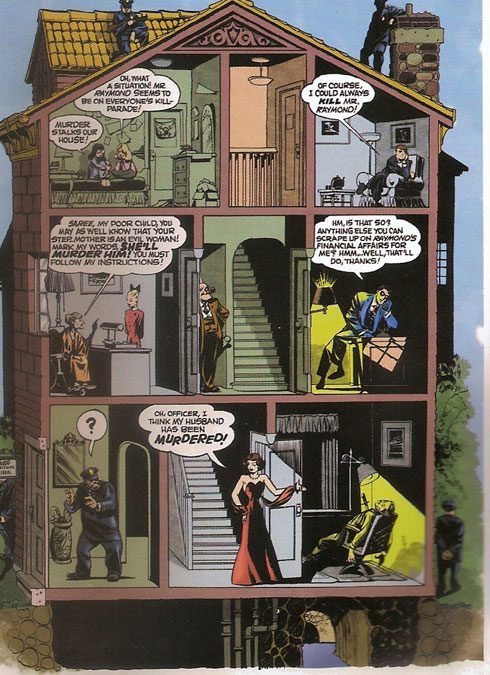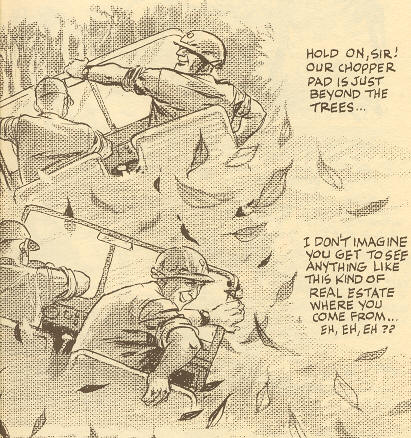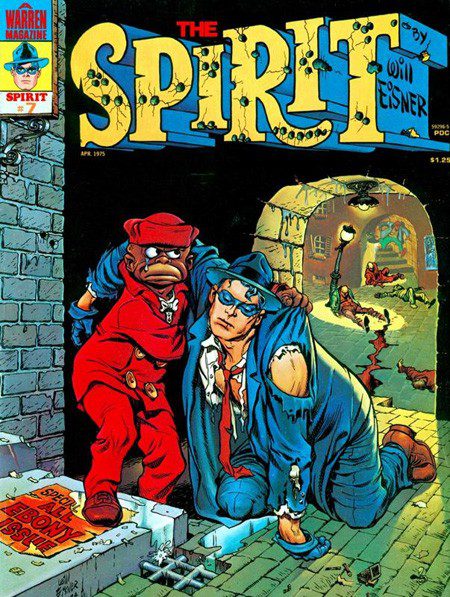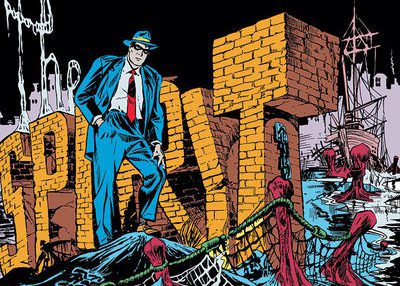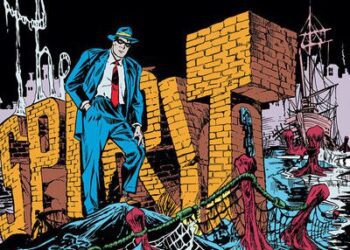
BY ADAM MCGOVERN
It is a contemporary American cliché to “think outside the box” when confronted with social obstacles or outmoded ideas. The comics artform, with its discreet vignettes and rigid conventions, was founded on boxes even from the moment that its maverick aesthetic came into being. Though its artistic possibilities and commercial potential were uncharted territory, it was quickly mapped into square panels, like the frozen frames of a film, and into set genres with standard personality types — the staunch Western lawman, the square-jawed detective, the upstanding superhero. Will Eisner put new contents in these boxes, and in time transformed the world inside them while metamorphosing and melting the “box” most literally. The Spirit is the first Pandora’s box he cracked open, eventually extracting riches that would change and elevate the comics medium irreversibly.
Eisner grew up in the “box” of early 20th century tenements and determined social expectations. Like many of the American comics artform’s founders, he was a member of the first-generation Jewish population whose bounded options led them to apply their ingenuity in a castoff cultural context — the ephemeral yet vital new medium of comics. While the imaginations of its young, deprived practitioners ran wild with the extension of pulp tropes and the innovation of vivid and transformative superheroes (a wholly new incarnation of the mythic and folkloric archetypes that each age seems to need to help define itself), Eisner soon felt constrained by the commercial and artistic parameters that coalesced around what came to equal success in the nascent comics industry — violence, simplicity, juvenile taste. He also saw himself as just one link in a swiftly emerging order of hardworking freelancers and increasingly enriched publishers, creating many characters and co-running his own shop (with Jerry Iger) to mass-produce content for comics companies but seeing his financial security remain in doubt and his incipient artistic ambitions stay unfulfilled.
When the chance to produce a newspaper supplement in the tradition of the more-respected comic strips but the format of the newly-popular comic books arose, he jumped at the opportunity, and demanded ownership and editorial control of his creation. The result was The Spirit, the first comic book aimed at adults rather than children and adolescents, and the first to draw on, and aspire to cultural equivalence with, other accepted artforms, from the Damon Runyon short stories with which it shared its satirical true-crime tone to the gangster movies from which it derived its dramatic look. It was also the earliest comic to attempt a novelistic wholeness to its narratives; each episode was a well-crafted and self-contained short story, and taken in sequence the hundreds of episodes that appeared from 1940-52 show a growth and change that many story cycles and prestige TV series today would still envy. Defiant of the boundaries of commercial consistency, the very logo of the strip would change each week; dissatisfied with the “box” of conventional comics’ picture-frames, the panel-borders would often be worked into the composition of the story itself in a less arbitrary and more ambitious manner — the proscenium of a doorway doubling as a story’s opening panorama, the levels and sections of a building seen in cutaway view standing in for the tiers and compartments of a standard paneled page.
In this volume, we see views from the first six years of Eisner’s increasingly daring progression beyond the boundaries he perceived. The earlier episodes, though stylish and cerebral from the start, suggest little of the advances to come, but fortunately Eisner had no fear of stretching beyond what he himself knew he could accomplish, and a sense of adventure is clear even before the most convincing evidence that it has been fulfilled. Over time, even halfway through Eisner’s first great oeuvre (the second would come with his pioneering and perfecting of the graphic novel from the late-1970s to his death in 2005), we see him loading the comics “box” with new ideas and vivid elements, and in turn expanding the boundaries of what the medium could be.
Other artists redrew the box in different ways. Comic characters’ definition depends on dynamic adversaries and fertile foils, and an understanding of Eisner himself is deepened by comparison to the figure most consider his complement and opposite in American comics history. Jack Kirby grew up at the same time and in similar circumstances to Eisner. While Eisner quickly jumped from leading assembly-line production of superheroes and action stories for growing corporations’ benefit and established unprecedented (and, for many years, unduplicated) creative control and independence with The Spirit, Kirby was one of the toilers in such shops (including Eisner’s own), and remained a work-for-hire footsoldier for most of his life. Eisner came to be the founding father of what is viewed in the U.S. as “indie” or “art” comics (introspective, autobiographical and art-vérité), while Kirby became the patron saint of “mainstream” or “genre” comics (crime, romance, science fiction and above all, superheroes). The two pillars of American comics — which have often stiffened into warring camps — are embodied by these two men, though Eisner and Kirby themselves were lifelong friends and mutual admirers.
This doesn’t mean they weren’t different — the comics medium thrives on variety and opposition, and its finest practitioners are no less distinct. Throughout their lives, Eisner and Kirby found themselves in circumstances that conveyed a very contrasting sense of possibilities. Though both were products of early 20th century ethnic ghettos, Kirby’s background was more working-class than Eisner’s, with less firm encouragement to follow his muse. Kirby ended up on the frontlines in WWII as an infantryman, while Eisner served on the homefront in communications (and was even able to supervise The Spirit while in uniform, whereas Kirby furiously stockpiled stories with his partner Joe Simon before heading overseas). After the war, Kirby would continue to be a low-paid contractor for the big comics companies, producing some of their most famous properties (he created or co-created most major superheroes, including Captain America, the Silver Surfer, the Hulk and the New Gods, and co-invented romance comics) but sharing in none of the wealth they generated, while Eisner would remain in control of his creative assets and gain the security to experiment with new artforms and advance his academic reputation.
However, the dissimilarities between the two artists are, in keeping with their unpredictable imaginations, not as simple as one might expect. One paradox of their progression is that Eisner is the one whose art and design are most often called “cinematic,” while Kirby’s comics are the ones which seem to have inspired more filmmakers. It is comics-industry legend (and self-evident fact) that each man’s 1940s output made extensive use of the era’s Hollywood examples; the shadowy atmospheres and emotional shadings of gangster movies and prototypical film noir exert a pervasive influence on The Spirit and Simon & Kirby comics like The Newsboy Legion. But beyond that the ways Eisner and Kirby applied these lessons diverge. Throughout his life, Kirby maintained a relatively conventional page structure of square and rectangular patterns in a standard grid; Eisner of course manipulated and morphed the panel structure almost from the start, telling his stories through the unconventional proscenia of windows and doorways, eye sockets, snapshot frames and more. Kirby raised the human form and the physical realm to a titanic intensity, yet adhered to an internal rulebook of reality; his characters were ideal personifications of human moods and values like the ancient gods he drew inspiration from, but his symbolism was allegorical, not abstract; Eisner regularly distorted scale and shape in ways which signaled the reader that reality was being refracted rather than represented: the tricks he played each episode with the way the Spirit strip’s logo is presented (as a series of improbably-shaped skyscrapers, as a rustle of blowing newspaper pages that happen to coalesce into language, etc.); the skewing of scale for dramatic effect (images of a giant Spirit looming over the scurrying prey in an implicitly verminlike underworld, etc.).
The strange byproduct of Eisner’s approach — no matter his gifts as an agile and seamless storyteller — is that it preferences the static image. We as readers pause in admiration of a series of sewer pipes arranged into the Spirit’s name; we are conscious of the artistry involved in a series of panels shaped like the interior of a postage stamp. In Kirby’s case, the panel-border was the only thing that didn’t move. He treated these “boxes” as a movie screen, and concentrated on giving an unprecedented sense of motion and story-progression within them. Where Eisner played with scale, Kirby orchestrated scope; he was legendary for perfecting the “splash page” (itself an Eisner innovation), that single panel which would take up an entire page — or sometimes two — with a panoramic image that evoked the widescreen vistas of blockbuster movies (long before the term was coined). Kirby’s kinetic compositions seem caught by a frenetic yet discerning viewfinder, and thus, though in their aesthetic they would move farther and farther away from the naturalism and physical logic of movies, they end up cinematic in their effects; ironically, Eisner’s work in comparison ends up more theatrical. Kirby’s scenes are framed; Eisner’s are staged.
This is not to say that the framework was of no concern to Eisner — page-composition and story-structure were where his particular literary and visual interests intersected. Eisner was sometimes fascinated with the way a story could be told (as in the morbid nursery-rhyme format of “Killer McNobby,” collected here), while in stories that were relatively commonplace visually, like “The Bloody Fang” (also in this collection), the intersecting narratives of a story some characters are reading and the events unfolding around them is a quietly revolutionary device for comics. The majority of comics artists, as defined by Kirby’s example, applied much of their creativity to what a comic could show; Eisner dedicated his to what a comic could say.
This is appropriate to the two artists’ divergent choices in subject matter; Kirby’s was action-centered, Eisner’s was emotion-centered. Kirby was broad and epic; Eisner was intimate and eccentric. It is interesting to note that, in later years, Eisner would eschew many of the compositional innovations with which he had revolutionized comics’ visual vocabulary. A late book like Last Day in Vietnam (detailing Eisner’s career as an armed forces journalist) connects to the reader’s mind with the vividness of surrogate memory and has little need of formal experimentation. We are closer to Kirby’s territory of the “camera eye” (but not cinematic tricks) to tell a story — though it really only seems that way. In Last Day as in many of Eisner’s later works, the panel structure is in fact radically loosened, flowing collage-like vignettes into each other in a way which sophisticatedly — and with great if unobtrusive originality — inscribes its depicted events in a kind of dream-frequency on the reader’s consciousness. Kirby could move you grandly, while Eisner stirs you personally. Each is, in the words of one of Eisner’s last book titles, a minor miracle, and it’s worthwhile to decode how Eisner’s miracle worked. No artist — especially one working in a popular arena and a competitive young medium defining its own rules — exists in isolation, and the contours of Eisner’s creativity were certainly shaped by those personalities occupying the other “panels” on history’s page which contrasted and complemented his.
There were some boxes Eisner himself couldn’t escape; amidst the American mythology of gangster cinema and hardboiled fiction you will see resourcefully transformed in these stories, you will find the American delusions of race sadly unchanged, principally in the character of Ebony. This demeaning caricature was a source of conflict in comics scholarship for decades, and Eisner wrestled with this blot on his legacy for almost as long. The D.W. Griffith of comics had his own Birth of a Nation, and was just as reluctant to acknowledge this single yet formidable transgression on a people amongst his many contributions to modern culture. In keeping with Eisner’s intellectual outlook, his eventual response to this controversy was not apologetic but analytical. In the foreword to his 2003 graphic novel Fagin the Jew, itself a redress of anti-Semitic stereotypes in Dickens’ classic Oliver Twist, Eisner anatomizes the evolution of his attitude toward the Ebony character, taking into account how sensibilities changed over time and how other voices were added to the dialogue on racial representation in the U.S. It is an admission of error without explicit contrition, but then Eisner may feel insulated by the latitude he himself allows Dickens in the same essay, judging the author misguided and ill-informed rather than malicious in his characterization of Jews.
Eisner would regularly reassess some of his own most admired creations from perspectives that could dismay their avid fans (for instance, his genial dismissal of the aviation-squadron strip Blackhawk as “fascist” though it has had an ardent cult following since its WWII inception). And he periodically would point out that the Ebony character keyed into prevailing stereotypes of its day, and note that some Black readers and associations would commend him for the relative humanity and mildness of Ebony’s persona, more lovable than laughable and more sidekick than servant, in an era of movie and radio stereotypes that were much more humiliating. Still, the approval of perhaps strategically accommodationist spokespeople for the Black community, settling for gestures toward dignity in a dangerous era, does not relieve Eisner of his responsibilities to record a full humanity that he would have had easy access to among writers, performers and thinkers of the Harlem Renaissance era. Few comic creators committed themselves so conspicuously to a racial stereotype (Ebony was central to The Spirit while Kirby’s racial stereotypes were minor characters abandoned early), and few defended their good intentions for as long (Kirby would be openly regretful, and cite a remedial need, in co-creating later characters like the Afro-centric Black Panther; Phantom/Mandrake the Magician creator Lee Falk would disdain his earlier perspectives in upgrading the character of Lothar from servant to equal partner of Mandrake as the series progressed). Eisner’s genius is gauged by the extent to which he transcended the prevailing vision of his times; his shortcomings shouldn’t be exempted from that measure. And to be partitioned from colleagues who came to a greater understanding before he did is a “box” it would be beneath Eisner’s stature to take refuge in.
Still, demonstrable action in later life speaks louder than public apology for the immutable past, and Eisner’s nuanced portraits of the Jewish ghettos with which he had once eschewed cultural identification, as well as three-dimensional portrayals of Asians in Last Day in Vietnam and respectful interpretations of Black historical giants like the legendary Malian emperor in Sundiata, would show that, however begrudging of readers’ critiques of his earlier mistakes, his sensibility caught up with his formal evolutions well before his career ended. Eisner did assert that a form of caricature is necessary in the broad-brush comics medium, but came to a mature theory of how that caricature can be a matter of benign shorthand rather than malign distortion, also detailed in his Fagin foreword.
But the final chapter of so forward-thinking and ambitious a creator as Eisner is truly for those who come after him to write. Eisner initiated an odyssey into popular art’s possibilities that wasn’t meant to stop with him. In this volume, you see him first crack open a treasure box of ideas. It’s a timeless story on which the book cannot be closed.
[Adam McGovern writes on comics and culture at Tor.com, HiLoBrow.com, ComicCritique.com, LA Review of Books and elsewhere, and publishes comics with his artistic collaborators in such anthologies as Magic Bullet and POOD. A remembrance of Will Eisner can be found at HiLoBrow here and a comic homaging Eisner’s legacy here.]
The New York Comics & Picture-Story Symposium is a weekly forum for discussing the tradition and future of text/image work. Open to the public, it meets Tuesday nights at 7-9 p.m. EST in New York City. Presentations vary weekly and include everything from historical topics and technical demonstrations to creators presenting their work. Check out upcoming meetings here.

